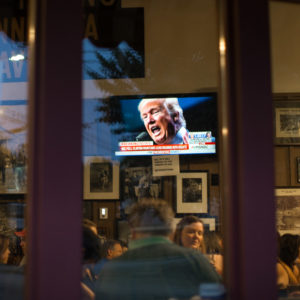Voters view presidential elections through kaleidoscopes. At certain moments they focus, give it a turn — and everything looks different. That’s why it’s never smart to predict the outcome too early or on the basis of a single turn.
We’ve seen many false prophesies already this year. In the beginning, Former Florida Gov. Jeb Bush was crowned the likely Republican presidential nominee. That didn’t work out. Then, Florida Sen. Marco Rubio and Texas Sen. Ted Cruz were each seen as potential frontrunners at various points, but neither made it. For a while, surgeon Ben Carson was running first and businesswoman Carly Fiorina was a two-debate sensation. Ultimately, of course, Donald Trump rolled over them all.
If I had been paid five dollars every time an all-knowing expert make an erroneous prediction during this year’s primaries, I’d now have enough money to start my own super-PAC.
So far in the general election, we’ve seen the race turn a few times. Trump briefly surged after the Republican convention. A CNN poll put him 5 points ahead. But, a week later, Clinton took the lead after her party’s convention. In early August, a McClatchy/Marist poll had her leading by 14 points — and the word “landslide” entered the lexicon.
Before the debate, however, Trump had the momentum — especially in critical states, from Ohio to Pennsylvania, Iowa to Colorado. Street buzz was all about Clinton blowing what should have been an easy race. Her handling of personal health issues compounded the troubles. Rumors were spread that she may even quit.
But, after the debate, the kaleidoscope turned again. Most voters thought Clinton won the showdown. Two polls gave her a 23-point advantage. A Morning Consult poll found that 58 percent of Trump’s own supporters said he won the debate, while 86 percent of Clinton’s supporters said she did.
Clinton still carries heavy baggage and is widely viewed by voters as dishonest, but since the debate she has regained self-confidence and Trump is once again tied up in multiple controversies of his own making. His messes are giving Clinton another chance to gain steam.
For example, a new survey from Public Policy Polling shows that a majority of voters believe Trump does not pay his fair share in taxes. By a 60 percent to 10 percent margin, voters think Trump’s comments about the weight of a former Miss Universe were inappropriate — even 45 percent of his supporters were unhappy with their candidate’s remarks. Particularly worrisome for Trump is that most voters say he’s more likely to cause a nuclear war than is Clinton. One in five Republicans agree with that assessment.
Despite all that, the race remains close. There are plenty of opportunities for new twists and turns. We still have two presidential debates on the horizon, and each candidate has a lot of banana peels to sidestep. There is time for Trump to make a comeback — or, for Clinton to widen her current advantage. At this stage of the game, mistakes are costlier than ever.
As we enter the home stretch, Americans have low opinions of both candidates and they’re not pleased with the campaign’s tone. A Monmouth University poll found that 70 percent of voters think this election has brought out the worst in people — only 4 percent think it has brought out the best — and nearly two-thirds think the harsh language used on the stump is unjustified.
There is both restlessness and resignation in the air.
When public opinion is a cauldron of frustration, distrust and anger, as it is this year, anything can happen. Voters want change — many want to turn Washington inside out — but they also fear giving a blank check to someone who has never governed. Ten percent of the vote is still up for grabs, and that’s enough to flip the lead once or twice more.
Even though early voting has begun and get-out-the-vote drives are underway, there is still more to come in the 2016 election. That, you can take to the bank.
It ain’t over ‘til it’s over.

